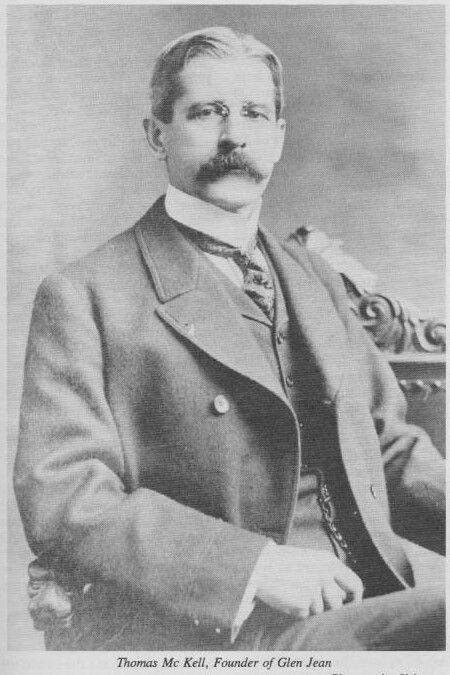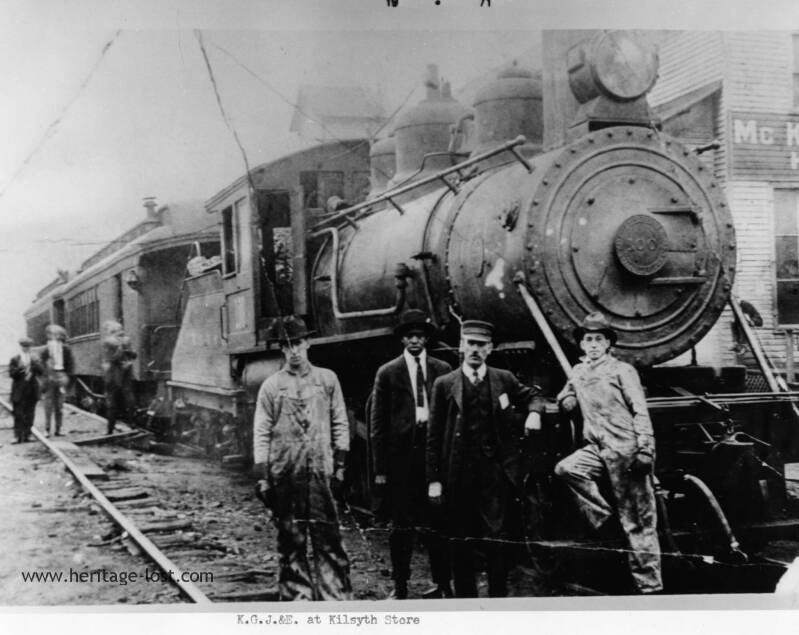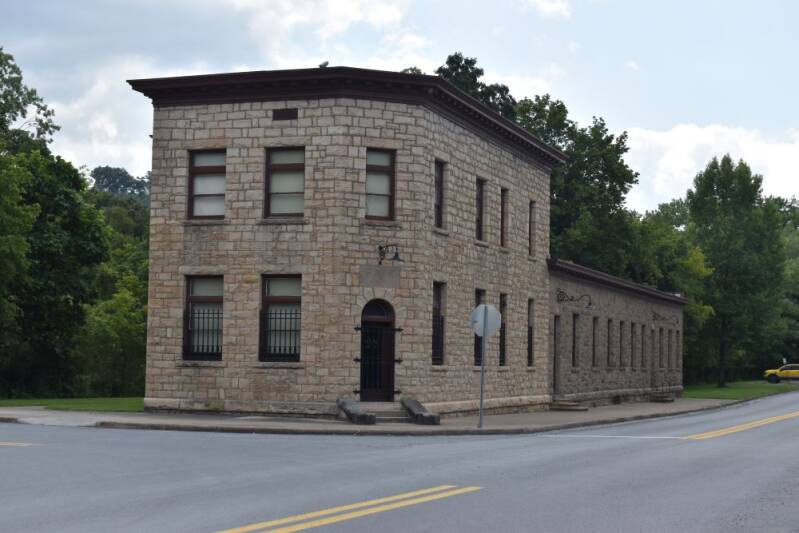Glen Jean
The town of Glen Jean is one town near the New River Gorge but not located directly in the Gorge itself like Thurmond, Quinnimont or Nuttallburg.
It is located on the rim of the Alleghany Plateau, not deep inside the New River. It was called at one time, McCoy's Mill, but like many other unheard of locations in the Gorge, it, too, was destined to help feed the growth of the New River Gorge area.
What originally started out as a simple 12,500 acres which was owned by the Dun family since the Revolutionary War, this land became a wedding gift. A 23 year old businessman from Chilicothe, Ohio was about to marry into a small fortune, but a fortune that he himself would carve out.

Young Thomas Gaylord McKell wedded Jean Dun, the daughter of John Dun, a very wealthy scottish immigrant businessman. John Dun gave McKell the obscure 12,500 acres in Fayette County as a wedding gift. It is believed that Dun knew of the financial importance of the land with the C&O Railroad carving its way through the New River area. It was said that John had wanted to give Thomas the opportunity to start his own path to wealth with the knowledge of the vast natural resources that the land contained.
It was also said that during the time that Capt. Thurmond was off surveying the land for John Bowyers, Thomas McKell was already sending his own survey crew to look over his new land holdings and report back. Thomas McKell and his new bride soon visited the area, possibly crossed the river at Thurmond and rode the 7 miles up Loop Creek towards McCoy's Mill, on horseback.
Thomas Gaylord McKell source NPS
Two major coal seams lie within the New River Gorge, that of the Sewell seam and the Fire Creek seam. Both very good coking coal and used in the manufacturing of steel in northern steel mills. The land McKell owned contained both seams of coal and vast virgin timber. Impressed by the reports he received from his survey crews and his own eyes. Thomas McKell purchased an additional 12,500 acres of land, which some report that the additional land purchases were made from Jeans family who owned heir-ship land in the area. He then decided to settle on McCoy's Mill as a headquarters for what was to become his vast empire of assorted, prosperous businesses. He built a town, naming it Glen Jean, in honor of his wife Jean.
Thomas McKell was a shrewd businessman and determined to make his wealth in the area. His holdings stretched from banks, to railroads. he leased land to other coal companies, built homes and rented those to workers who came into the area searching for a job. By 1904, 10 coal companies paid him royalty on the coal they mined from his land and he even hand his own mine called McKell Coal and Coke. All of this only came into fruition after he made another expensive investment in his endeavors. Enter his railroad, the Kanawha, Glen Jean and Eastern Railway.
Thomas' vast resources and plans he had for those resources had one little glitch to overcome before his vision could become a reality. The little glitch was a simple one, yet a massive one to boot. His land holdings were up Loop Creek, directly across river from the town of Thurmond. The C&O railroad ran on the Thurmond side of the river and not on McKell's Loop Creek side. One key important thing was missing...a bridge across the river at Thurmond!
Proposed railroad map for the K.G.J.&E Source C&O Historical Society
The land that Thomas McKell owned consisted of vast natural resources including coal and timber. Natural gas resources would come at a much later date. McKell began operating the McKell Coal and Coke Company, thus needing a way to get his product to market.
He had leased the coal mining rights to different mining companies across his land and the C&O only serviced to Glen Jean. By 1894, the line had extended to to the community of McDonald and known as the Loup Creek Branch. History recalls that in 1895, a rival railroad was interested in putting in a new line to the community of Deepwater, WV. Not wanting to be outdone by any competition, McKell soon began construction on his own, shortline railroad.

McKell reportedly approached the C&O about building a bridge and putting in a railroad branch line up Loop Creek to service his land holdings. But, to be known, the C&O was not interested in investing the money to build the Thurmond bridge. Little is known as to why the railroad would not invest the money in building the bridge. McKell remained persistent. He returned to Ohio and gathered financial support, possibly investors, and returned to the C&O with a proposition they probably could not resist. In 1887, he offered to fund the bridge himself in return for the C&O to lay track up the 7 mile hollow to Glen Jean. He gave the road the right- of -way across his land, land the C&O did not have to purchase. The railroad agreed and by November 7, 1893, the line was finally completed to Glen Jean and the first coal was shipped down Loop Creek to Thurmond from the Collins Colliery Company in Glen Jean. But in 1908, disaster hit the line when a flood washed away the bridge in Thurmond.
K.G.J.&E engine crew at Kilsyth, WV source, C&O Historical Society
In 1900, the KGJ& E was completed to connect McKells coal and coke mine in Derr Hale, (Derryhale today). And in 1903, the line was completed to Kilsyth, linking all coal producing communities together from Thurmond to Pax. It was reported that the K.G.J.& E. joined the then Virginian Railway, (now the Norfolk and Southern Railroad), in Pax. Possibly due to a dispute between McKell and the C&O Line. It has also been reported that, at the height of its glory, the KGJ&E had at least five steam engines, an untold number of passenger cares and over 200 coal cars. But despite its name, the Kanawha, Glen Jean & Eastern, never made it to Kanawha County. The line was purchased in 1940 by the C&O and made Loup Creek part of their line. Today, the C&O, (currently CSX Transportaion), Loup Creek to Pax is owned by CSX but maintained and operated by the RJ Corman Railroad Group.
Thomas McKell, as previously stated, was indeed a very shrewd businessman and sought financial opportunity where ever he could. On the Thurmond page, it discussed how William Thurmond, the towns owner, was a devout Baptist and did not allow drinking, gambling or prostitution in the town of Thurmond. McKell seen a potential for financial gain through Thurmond's rule of no illicit behavior in the town itself.
Around 1901, McKell built the Dunglen Hotel, directly across the river from Thurmond, where the Loop Creek or Dunloup Creek flowed into the New River. It was a lavish hotel, once called the "Waldorf of the Mountains". It was over 4 stories high, with 100 beautifully decorated rooms. Wrap around deck and ballroom. Gambling hall, which according to Ripley's Believe it or Not and the Guinness Book of World Records, as holding the longest, continuous poker game...14 years in fact. It was estimated that in that length of time that over $100,000 were lost during that long game.
The Dunglen welcomed all the things that William Thurmond outlawed across the river in Thurmond. Visitors from all over flocked to the resort. It contained a grocery store, bank vault, lavish ball rooms, laundry, barber shop, a bar and enormous gambling hall. Rooms were $2.50 a night and even reported that on its opening night, a massive crowd gathered to hear a band from Cincinnatti, Ohio play.
Thomas did not live long enough to see his investment pay off. He died three years later in 1904. His son, William, a Yale graduate, continued running the McKell holdings in West Virginia.
History recalls the Dunglen Hotel as "Dodge City of the east", "no Sunday west of Clifton Forge and no God east of Hinton," and the infamous, "Whats the difference between Hell and Thurmond?, a river runs through Thurmond."

The Dunglen Hotel source NPS
Thomas McKell died in 1904 at the age of 58, he was buried back in his home town of Chilicothe, Ohio. His wife Jean Dun McKell died in 1926 at the age of 82, she, also, was buried in her home town of Chilicothe, Ohio. Their son William took over the family business in Glen Jean and ran it as his father would. Sadly, William did not have any heirs when he passed away and soon after, Glen Jean and the McKell holdings began to fade away.

